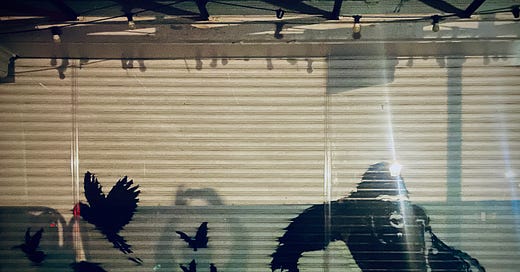LAST NIGHT I WALKED DOWN to see the latest animal stencil attributed to Banksy. It is the ninth to appear in as many days around London. This time it is an image of a gorilla, lifting a sheet, from which fly several birds. It was spray-painted on Monday night on the entrance shutter to London Zoo, on the Outer Circle of The Regent’s Park.
Two men were guarding the image. They were on duty all night and chatting away the first few hours. The shutter has already been put behind glass, and cordoned off with metal barriers. It will soon be removed they say, and put on display inside the Zoo. The guards watched the CCTV footage of the stencil being put in place and sprayed. It was done by seven people, four women, three men, all in their fifties. As we chatted people wandered up, trying to find the best vantage to take photographs of the gorilla. Two paramedics, who had parked a little way along the Outer Circle, were taking selfies.
‘What does it all mean?’, one of the guards asked, cheerfully invoking the line that has been repeated breathlessly in the media over the past week.
I’ve been thinking about this question for some time, in relation to ‘Banksy’ — or Robin Gunningham (as he is otherwise known), as a phenomenon. It is perplexing. The images he creates are themselves never particularly interesting, with their one-dimensional political messages and greeting-card radicalism. And yet they have ‘captured the public imagination’, claim arts news reporters, as well as his lucky art dealers, who have long banked on the Banksy asset class, trading on his supposed radicalism and the simple trick of anonymity.
Over the past week the story of the animals seems less one of a lone radical, bally over the head and spray can in hand, but more along the lines, considering the CCTV revelation at London Zoo, of an episode of Secret Seven and the Mysterious Animals. But… what does it all mean? They might make us think, briefly, of ecological collapse and mass extinction, although the truth is more that they offer light relief at having something appearing in public life — in public space — that is not violent or divisive, at a time when riots over migrants and asylum seekers, a subject that Gunningham-Banksy has alluded to elsewhere, have dominated public life.
The wider truth about Gunningham-Banksy is that for a long time he has, to a quite remarkable extent, monopolised the attention of the arts news media. Not just the tabloids, but also reputable outlets such as The Guardian, the BBC, and even trade papers like The Art Newspaper, have for years published stories on him weekly, if not daily. The unthinking obsession is astonishing. Why so much space given to this eye-catching but essentially lack-lustre work, rather than far more interesting art by those not reliant on anonymity, not buoyed by endless repetitive news items, and not dependent on an unregulated and clearly collusive art and auction market? Would an anonymous woman artist be so successful? If Gunningham-Banksy is such a great figure (greater than Picasso, Leonardo, and even Tracey Emin, according to search figures on the BBC website), why are none of his works held in the collection of national museums, such as the Tate?
Such questions are never asked. If they were, it might become a little clearer that Gunningham-Banksy’s true medium is not the spray-painted stencil image, nor even the Secret Seven who execute his designs, but rather the unthinking and all-too submissive arts media itself.




